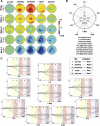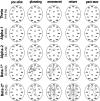Temporal evolution of oscillatory activity predicts performance in a choice-reaction time reaching task
- PMID: 21047934
- PMCID: PMC3023373
- DOI: 10.1152/jn.00778.2010
Temporal evolution of oscillatory activity predicts performance in a choice-reaction time reaching task
Abstract
In this study, we characterized the patterns and timing of cortical activation of visually guided movements in a task with critical temporal demands. In particular, we investigated the neural correlates of motor planning and on-line adjustments of reaching movements in a choice-reaction time task. High-density electroencephalography (EEG, 256 electrodes) was recorded in 13 subjects performing reaching movements. The topography of the movement-related spectral perturbation was established across five 250-ms temporal windows (from prestimulus to postmovement) and five frequency bands (from theta to beta). Nine regions of interest were then identified on the scalp, and their activity was correlated with specific behavioral outcomes reflecting motor planning and on-line adjustments. Phase coherence analysis was performed between selected sites. We found that motor planning and on-line adjustments share similar topography in a fronto-parietal network, involving mostly low frequency bands. In addition, activities in the high and low frequency ranges have differential function in the modulation of attention with the former reflecting the prestimulus, top-down processes needed to promote timely responses, and the latter the planning and control of sensory-motor processes.
Figures



Similar articles
-
Cortical beta-band power modulates with uncertainty in effector selection during motor planning.J Neurophysiol. 2021 Dec 1;126(6):1891-1902. doi: 10.1152/jn.00198.2021. Epub 2021 Nov 3. J Neurophysiol. 2021. PMID: 34731060
-
Attention modulation regulates both motor and non-motor performance: a high-density EEG study in Parkinson's disease.Arch Ital Biol. 2010 Sep;148(3):279-88. Arch Ital Biol. 2010. PMID: 21175014 Free PMC article.
-
Cerebral-cortical networking and activation increase as a function of cognitive-motor task difficulty.Biol Psychol. 2012 May;90(2):127-33. doi: 10.1016/j.biopsycho.2012.02.022. Epub 2012 Mar 3. Biol Psychol. 2012. PMID: 22410264
-
Neural oscillatory responses to performance monitoring differ between high- and low-impulsive individuals, but are unaffected by TMS.Hum Brain Mapp. 2021 Jun 1;42(8):2416-2433. doi: 10.1002/hbm.25376. Epub 2021 Feb 19. Hum Brain Mapp. 2021. PMID: 33605509 Free PMC article. Clinical Trial.
-
Neural correlates for task-relevant facilitation of visual inputs during visually-guided hand movements.Neuroimage. 2015 Nov 1;121:39-50. doi: 10.1016/j.neuroimage.2015.07.033. Epub 2015 Jul 17. Neuroimage. 2015. PMID: 26191651
Cited by
-
Modulation of Gamma Spectral Amplitude and Connectivity During Reaching Predicts Peak Velocity and Movement Duration.Front Neurosci. 2022 Feb 24;16:836703. doi: 10.3389/fnins.2022.836703. eCollection 2022. Front Neurosci. 2022. PMID: 35281507 Free PMC article.
-
EEG Single-Trial Detection of Gait Speed Changes during Treadmill Walk.PLoS One. 2015 May 1;10(5):e0125479. doi: 10.1371/journal.pone.0125479. eCollection 2015. PLoS One. 2015. PMID: 25932947 Free PMC article. Clinical Trial.
-
Neural activations during visual sequence learning leave a trace in post-training spontaneous EEG.PLoS One. 2013 Jun 14;8(6):e65882. doi: 10.1371/journal.pone.0065882. Print 2013. PLoS One. 2013. PMID: 23799058 Free PMC article.
-
Neural fatigue due to intensive learning is reversed by a nap but not by quiet waking.Sleep. 2021 Jan 21;44(1):zsaa143. doi: 10.1093/sleep/zsaa143. Sleep. 2021. PMID: 32745192 Free PMC article.
-
Beta Oscillatory Changes and Retention of Motor Skills during Practice in Healthy Subjects and in Patients with Parkinson's Disease.Front Hum Neurosci. 2017 Mar 7;11:104. doi: 10.3389/fnhum.2017.00104. eCollection 2017. Front Hum Neurosci. 2017. PMID: 28326029 Free PMC article.
References
-
- Andersen RA, Buneo CA. Intentional maps in posterior parietal cortex. Annu Rev Neurosci 25: 189–220, 2002 - PubMed
-
- Batista AP, Buneo CA, Snyder LH, Andersen RA. Reach plans in eye-centered coordinates. Science 285: 257–260, 1999 - PubMed
-
- Battaglia-Mayer A, Caminiti R, Lacquaniti F, Zago M. Multiple levels of representation of reaching in the parieto-frontal network. Cereb Cortex 13: 1009–1022, 2003 - PubMed
-
- Bernier PM, Burle B, Hasbroucq T, Blouin J. Spatio-temporal dynamics of reach-related neural activity for visual and somatosensory targets. Neuroimage 47: 1767–1777, 2009 - PubMed
Publication types
MeSH terms
Grants and funding
LinkOut - more resources
Full Text Sources

